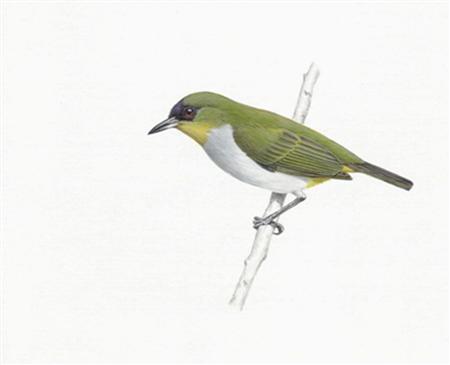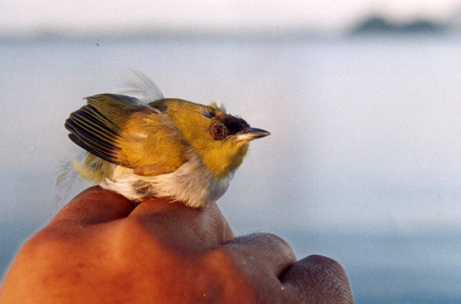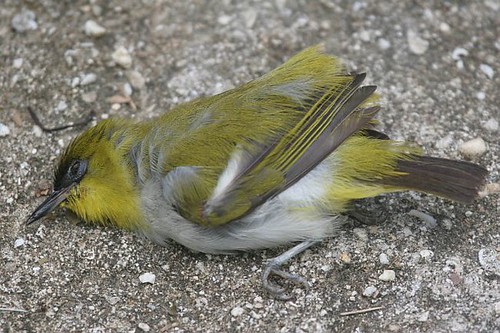tags: researchblogging.org, birds, aves, ornithology, Zosterops somadikartai, Togian white-eye, Indonesia, Sulawesi
An undated artist's rendering of Zosterops somadikartai, or Togian white-eye.
This small greenish bird that has been playing hide-and-seek with ornithologists on a remote Indonesian island since 1996, but was declared a newly discovered species on March 14, 2008 and promptly recommended for endangered lists.
Image: Agus Prijono.
Sharp-eyed scientists have discovered a new species of bird on a remote Indonesian archipelago in the Southern Pacific Ocean. A formal description of this new species, the Togian white-eye, Zosterops somadikartai, was just published in the March issue of the ornithological journal, The Wilson Journal of Ornithology. Not only was this bird recognized as a new species, but its population and home range were so small that this species was recommended to be added to international endangered species lists.
This energetic green-and-yellow bird was first spotted by Mochamad Indrawan, of the University of Indonesia, and his colleague Sunarto, who is currently working on a doctorate at Virginia Tech, in 1996. (Sunarto, like many Indonesians, uses only one name). The pair later returned to learn more about its behaviors and habits in the wild and to record the bird's song.
"We observed the species in the field from 1997 to 2003," said Indrawan. They also collected the type specimen upon which this species' formal scientific description is based.
After collecting the type specimen, Indrawan collaborated with his mentor, Soekarja Somadikarta, Indonesia's leading taxonomist, and Pamela Rasmussen, an internationally known ornithologist at Michigan State University who specializes in Asian birds, to verify this little bird's status as a distinct species.
Rasmussen's taxonomic studies required detailed and painstaking comparisions between the newly collected type specimen and its closest relative, the very similar-looking black-crowned white-eye, Zosterops atrifrons. Specimens of this new bird's "sister species" that were collected during the previous one hundred years are held by several natural history museums around the world, such as Britain's Natural History Museum, the American Museum of Natural History in New York City and the Smithsonian Institution in Washington DC.
Male Togian white-eye, Zosterops somadikartai.
Malenge, Togian Islands, Indonesia, 15 December 2007.
Image: © Raphael Jordan [larger view].
The formal description reveals this small bird has more subdued plumage than its closest relatives; the white-eyes. It has a dark area on its face that sets off its soft greenish plumage, pale yellow throat and cream-colored belly and vent. However, unlike its cousins, for whom the white-eyes are named, this new species lacks their white feathery "spectacles".
"The new species is different from its closest family of Zosterops, or white circle-eye. Its eyes are circled by a band of red feathers, not white, and its beak is a more intense red," Somadikarta pointed out.
The newly described Togian white-eye is found only near the coasts of three small remote islands off Indonesia's Central Sulawesi province: Malenge Island, Batudaka Island and Togian Island, according to the scientists.
"We think it's endangered," Somadikarta added, noting that its habitat is less than 3,100 square miles. "We are still studying the number of the species' population, which is estimated at less at than 1,000."
Rasmussen said it likely falls into the International Union for Conservation of Nature's category of endangered.
While studying the birds' habits in the field, Indrawan recorded the Togian white-eye's song and Rasmussen later digitized it into a sonogram for analysis. According to Rasmussen, the bird's lilting song is distinct from that of its relatives; having higher pitched sounds and fewer variations in pitch.
"This finding of the bird is only the beginning given the vast opportunities with Indonesian landscapes and seascapes of endemic flora and fauna," enthused Indrawan.
"What this discovery highlights is that in some parts of the world there are still virtually unexplored islands where few ornithologists have worked," observed Rasmussen. "The world still holds avian surprises for us."
Such findings also reveal the importance of encouraging the training of international scientists and then collaborating with them, especially for increasing our understanding of tropical and island ecologies.
"This finding shows that equal opportunities are beneficial for the development of science and in particular that international cooperation can boost capacities in addressing poorly known biology in the tropics," Indrawan concluded.
Indonesia is home to roughly 1,600 of the known 10,000 bird species in the world, including many of the parrots I research.
Sources:
Indrawan, M., Rasmussen, P.C., Sunarto. (2008). A New White-Eye Zosterops from the Togian Islands, Sulawesi, Indonesia. The Wilson Journal of Ornithology, 120(1), 1-9.
Oriental bird images (photograph of the dead bird).
Also;




Cool. But, er, I think it's dated wrong.
thanks, i finally figured out that i mistakenly was "time machining" into the future. i hate it when that happens!
Why is there a picture of a dead one? Kind of depressing for an article about a new species. Perhaps the picture should be removed or replaced, in my opinion.
It's not dead. It's resting after a heavy squawk.
Quick, somebody, nail it to a perch!
Just like asshole scientists. They kill it.
Scientists are not a**holes. However, the taking of specimens - which is still being done very actively at several (if not many) universities, I believe to be a practice which is out of date. So the irony is that type specimens of the Togian Whiteeye were taken and then the species is moved immediately to the endangered species list. Why could we not change the practice of killing a bird stuffing a bird -as a study skin- to something better for teh birds... Scientists are too conservative-- no not a good word.... conservative implies conservation and in this situation killing one individual of a very rare species is not conservation.
why could we not take blood - do DNA work to show teh uniqueness, file the blood samples, photograph the bird until it feels like a Versace model, take every measurement known to mankind. clip a few feathers, etc etc etc.... but leave the bird in the habitat to at least try to allow them to breed.
The model of captive breeding is not working well in many species, and our illness of thinking we can "manage" a species out of the predicament only works a percentage of the time too. What we are finding is that some species need to be left alone in very good habitat. Study them softly. Others like California Condor are capable of being helped... breeding like big chickens. That is Great!
Others like Greater Prairie chicken are going down the tubes in many states and the irony there is that they are considered GAME BIRDS!!!! So the rules are different. How crazy!!!
this species is the subject of my next conservation film... We will be finished in 1 year- and take no specimens... but many beautiful images.